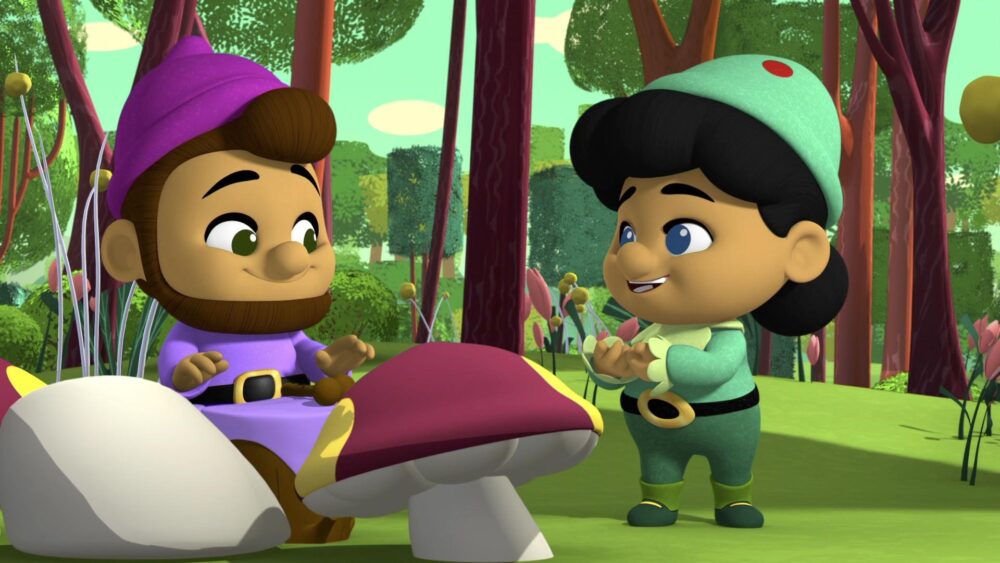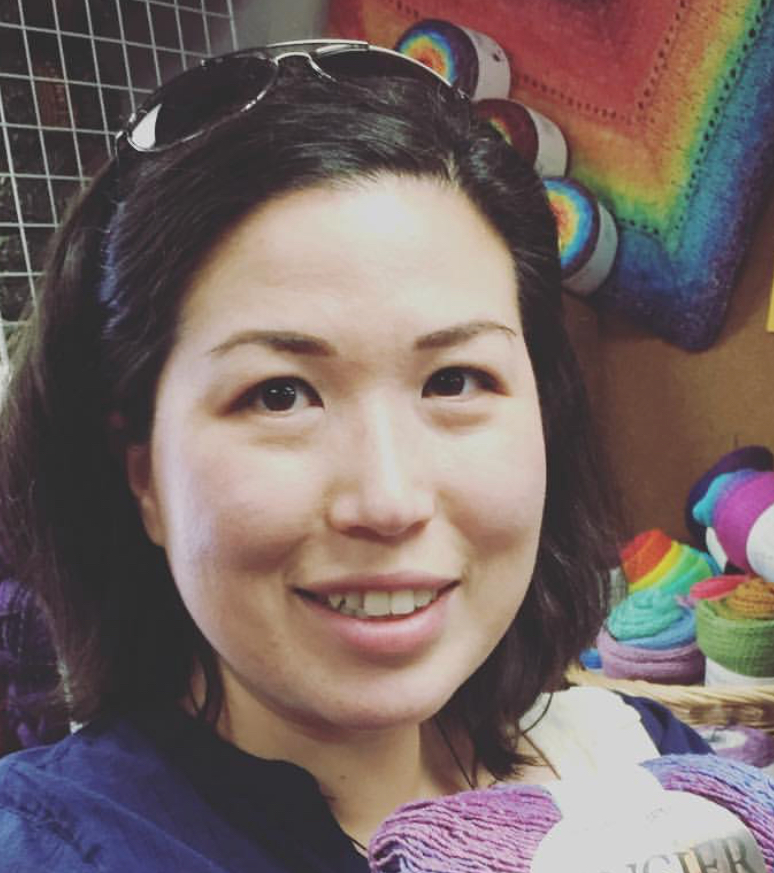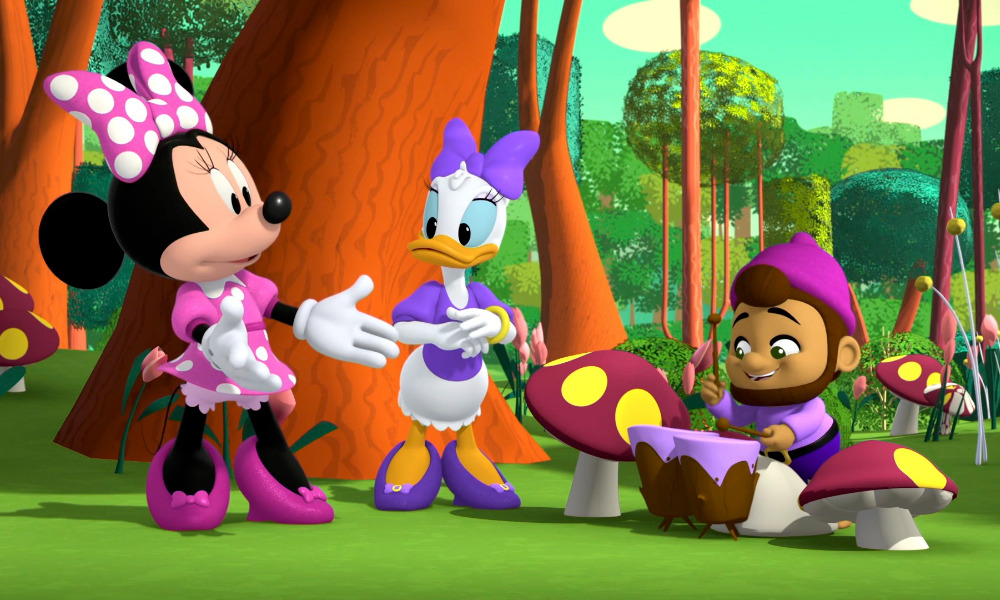This weekend, young viewers were introduced to a special new friend of the Mickey Mouse Funhouse when “The Music of the Seasons” premiered on Friday, May 13 on Disney Junior. Set to re-air throughout the month, this episode saw iconic Disney characters connect with Fig the gnome — a gifted drummer and music lover, who also happens to be deaf. In this new preschool adventure, Fig and his hearing sister, Olive, help Minnie and Daisy understand how he communicates and creates his danceable drum beats.
“The Music of the Seasons” was brought to screens by writer Kate Moran, who previously worked with the classic characters in Mickey Mouse Mixed-Up Adventures and has credits on Chip ‘n Dale’s Nutty Tales, Jake and the Never Land Pirates and Gravity Falls. In addition to drawing on her personal experience with deaf family members, Moran was aided by consultants (and brothers): RespectAbility board member and animation veteran Delbert Whetter (Igor, upcoming Pierre the Pigeon Hawk) and fellow deaf filmmaker/American Sign Language consultant Jevon Whetter (Live at the Deaf Club, upcoming Flash Before the Bang), who performed the ASL dialog for the animation team’s reference videos.
We caught up with the episode experts over email to find out more about developing Fig’s character, crafting an inclusive story for kids and how to adapt ASL for four cartoon fingers (or even no fingers). Disney Junior was also kind enough to provide a clip featuring Fig, Olive, Minnie and Daisy so you can watch them in action. (The character is expected to return for more Funhouse fun soon!)
Animation Magazine: How did you come up with the idea for Fig’s character?
Kate Moran: Fig is an amalgam of my deaf and hard of hearing cousins and two deaf drummers I’m a huge fan of.
I wanted Fig to be the kind of character my cousins and I would have delighted in seeing when we were children, where any differences are a wonderful addition to the character but not necessarily the defining characteristic of the character.
When it came to crafting the story and incorporating American Sign Language — did the most age-appropriate signs influence the story, or vice versa?
The story came first, based on my love of Fall (my favorite season), gnomes, music and the magic of letting people be their best selves.
What are the key goals and considerations when crafting an awareness message for young kids?
Kate: My main goal is to show that differences can bring wonderful things to friendships, that “normal” is a wider spectrum than previously represented.
Jevon Whetter: Our team is very mindful of the target audience when we create ASL dialog for animation — we will carefully choose ASL signs that are appropriate for young signers with a developing ASL vocabulary, especially if they are also early readers, which means captions may not be very accessible to them, if at all.
For such audiences, we often encourage creators to consider incorporating more visual elements into their content that complements its dialog or sound elements, which helps convey understanding and context while uplifting one’s imagination.
For instance, if a character is singing a song about life underwater, the content may include underwater features or fish in the form of graphics or animation in the background, or performing lyrics in ASL using nuances that resemble signing ASL while underwater.
What are the benefits (and perhaps challenges!) of using animation to explore real-life issues, disability and diversity?
Delbert: I am a long-time veteran of the animation industry with over 20+ years of experience in producing animated feature films. I have always believed we are uniquely positioned to be a leader in disability inclusion in Hollywood because there is literally nothing under the sun that cannot be created with or about people with disabilities. The only limit is one’s imagination.
With that comes countless possibilities and opportunities for storytelling, but that also means that we have an obligation to “get it right” by ensuring that we do not rely on old tropes or stereotypes but instead, tap into the rich tapestry of experiences that are represented by experiences of authentic persons with disabilities.
Kate: Animation can be an amazing medium to explore real-life issues! For example, I am grateful that Mickey and Minnie have a deaf friend and the positive impact that can have on children who see Mickey and Minnie being friends with someone like themselves.
I think representing some of these issues in animation can create additional challenges, like animating ASL — but I also believe that these challenges should be met head-on. It’s time. And the benefits far, far outweigh any additional effort needed. I want to say to these kids that they are absolutely 100% worth the effort to show them on screen. It just feels good to see someone who is like you.

It must have been hard to get those classic four-fingered cartoon hands to sign clearly. How was it managed?
Delbert Whetter: It is actually not hard at all… ASL is a language that incorporates body language and facial expressions just as much as it does the hands and fingers. We can communicate in ASL with just one hand while holding an object, for instance, or with fingerless mittens in cold weather, by adapting the way we express ourselves in ASL with careful nuances that often come naturally to deaf signers.
This is why it is so important to incorporate authentic, deaf-led professionals into the creative process, because the solutions to many of the challenges or conditions that deaf characters might find themselves in frequently can be found only within the lived life experience of an authentically deaf person. Moreover, many deaf performers are well-versed in the art of performing ASL as characters of all shapes, sizes and species such as lions or fantastical creatures for stage plays. For instance, in our animation work we have created ASL dialog for animal characters that have hooves, wings and claws.
How does it feel to put ASL in the gloved hands of such iconic Disney characters?
Delbert & Jevon: It is truly awe-inspiring — we feel so privileged and honored to connect young deaf and hard of hearing children with such iconic characters as Mickey and Minnie using ASL, a language that is visually accessible to them.
There have been a few other animated series introducing deaf or hard of hearing characters and ASL in recent months — do you think this is a function of culture, disability activism, the technological capacity of animation … all of the above?
Delbert: We have worked on a number of animated series incorporating animated ASL dialog for Disney, such as Big City Greens, as well as for other studios, and I can tell you without a doubt, that there is a clear uptick of interest and enthusiasm for deaf/hard of hearing animated characters and ASL dialog. But, more importantly, for other characters with other disabilities as well.
Much of this is due to the hard work of organizations like RespectAbility (I serve on their board of directors), which has tirelessly built relationships with children’s content creators throughout the industry to ensure that children with disabilities not only see themselves on screen, but can feel that their voices are seen and heard as well.
A key part of RespectAbility’s mission involves connecting creators with “behind the camera” professionals (such as writers, directors, producers, artists, etc.) with disabilities who not only know the industry but have lived life experience as a disabled person, which supplies them with plentiful creative material that is fresh, authentic and relatable for all.

Looking forward five years, how do you think disability diversity and representation in animation will measure up? How can the industry embrace more of it?
Kate: Looking forward five years, I would love for representation to not even have to be a conversation, that it is just normal — because it’s our world, this is what is outside in the lives we live. But getting there means that initially, it will take individuals making that effort to push forward these stories and characters. It can be intimidating to be the first or only voice to suggest it; do it anyway. Please.
Mickey Mouse Funhouse premiered in Summer 2021 and has been greenlit for a second season. New episodes air Fridays on Disney Channel and Disney Junior, available on demand through DisneyNOW.
Learn more about RespectAbility at respectability.org.













